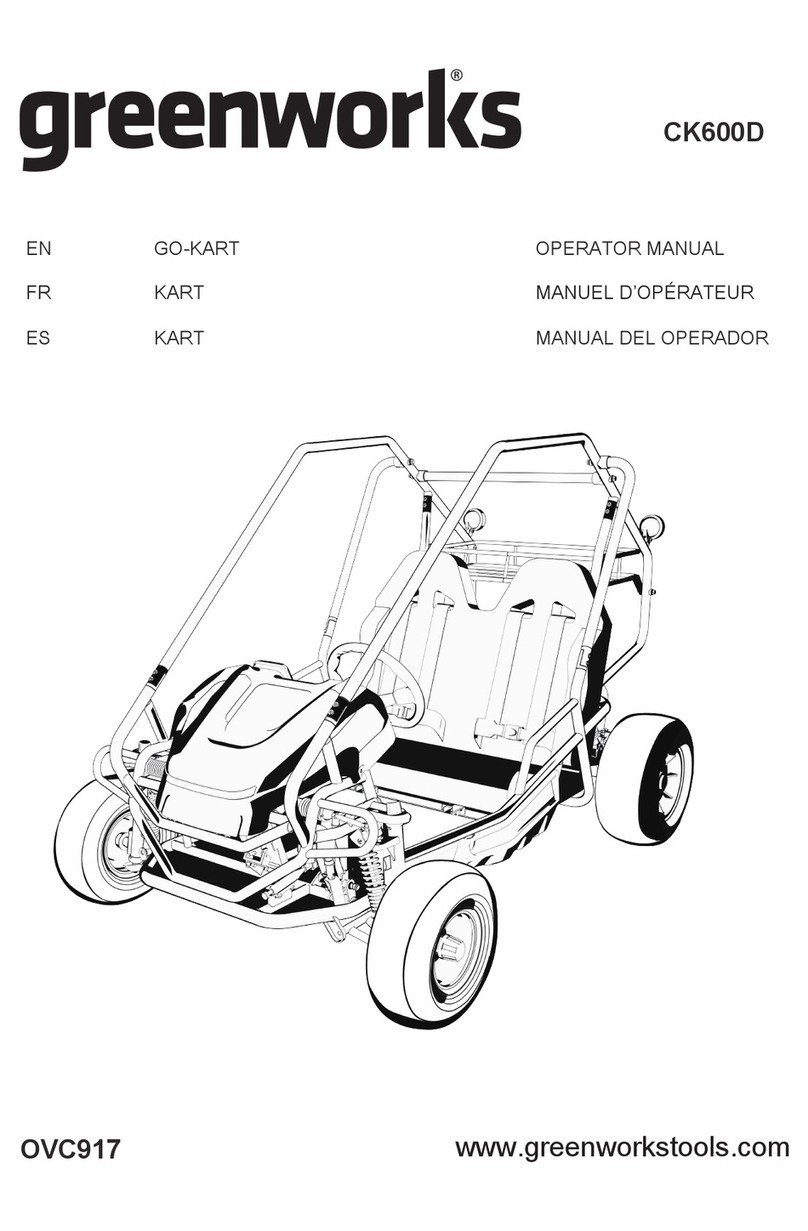
8
SAFETY
Operator Safety
Serious injury or death can result if you do not follow these instructions and procedures, which are
outlined in further detail within your owner’s manual.
• Read this entire manual and all labels carefully. Follow the operating procedures described.
• Never allow anyone under the age of 16 to operate this vehicle and never allow anyone without a
valid driver’s license to operate this vehicle.
• Do not carry a passenger until you have at least two hours of driving experience with this vehicle.
• No person under the age of 12 may ride as a passenger in this vehicle.
• All riders must be able to sit with backs against the seat, both feet flat on the floor and both hands
on the steering wheel (if driving) or on a passenger hand hold.
• The driver and all passengers must wear helmet, eye protection, gloves, long-sleeve shirt, long
pants, over-the-ankle boots and seat belt at all times.
• Always keep hands and feet inside the vehicle at all times. Always keep both hands on the
steering wheel and both feet on the floorboards of the vehicle during operation.
• Never permit a guest to operate this vehicle unless the guest has read this manual and all product
labels.
• To reduce rollover risk, be especially careful when encountering obstacles and slopes and when
braking on hills or during turns.
• This vehicle is for off-road use only. Never operate on public roads (unless marked for off-road
use). Always avoid paved surfaces.
• Never consume alcohol or drugs before or while operating this vehicle.
• Never operate at excessive speeds. Always travel at a speed proper for the terrain, visibility and
operating conditions, and your experience.
• Never attempt jumps or other stunts.
• Always inspect the vehicle before each use to make sure it’s in safe operating condition. Always
follow the inspection procedures described in this manual.
• Always travel slowly and use extra caution when operating on unfamiliar terrain. Be alert to
changing terrain.
• Never operate on excessively rough, slippery or loose terrain.
• Always follow proper procedures for turning. Practice turning at slow speeds before attempting to
turn at faster speeds. Never turn at excessive speeds.
• Always have this vehicle checked by an authorized GREENWORKS dealer if it has been involved
in an accident.
• Never operate this vehicle on hills too steep for the vehicle or for your abilities. Practice on smaller
hills before attempting larger hills.
• Never allow unauthorized persons to repair this UTV. This may affect vehicle performance and
cause injury.
• Do not wear loosen articles of clothing during operation, as these can be drawn into moving parts
on the vehicle and could cause a severe injury to occur.
• Always follow proper procedures for climbing hills as described in this manual. Check the
terraincarefully before attempting to climb a hill. Never climb hills with excessively slippery or
loosesurfaces. Never go over the top of a hill at high speed.
• Always follow the proper procedures outlined in this manual for traveling downhill and for
brakingon hills. Check the terrain carefully before descending a hill. Never travel downhill at high
speed.Avoid going downhill at an angle, which would cause the vehicle to lean sharply to one side.
Travelstraight down the hill where possible.
• Always check for obstacles before operating in a new area. Never attempt to operate over
largeobstacles such as large rocks or fallen trees. Always follow the proper procedures outlined
inthis manual when operating over obstacles.
• Always be careful of skidding or sliding. On slippery surfaces such as ice, travel slowly
andexercise caution to reduce the chance of skidding or sliding out of control.
• Never operate your vehicle in fast-flowing water or in water deeper than that specified in
thismanual. Wet brakes may have reduced stopping ability. Test your brakes after leaving water.
Ifnecessary, apply them lightly several times to let friction dry out the pads.
• Always be sure there are no obstacles or people behind your vehicle when operating in reverse.






























